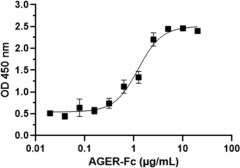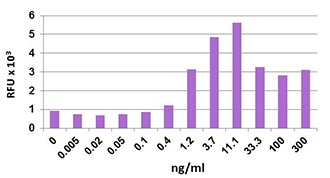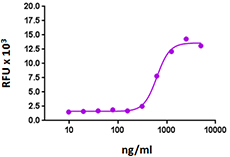- Regulatory Status
- RUO
- Other Names
- Advanced glycosylation end product-specific receptor, Receptor for advanced glycosylation end product, RAGE
- Ave. Rating
- Submit a Review
- Product Citations
- publications

-

EC50= 0.8 - 3.2 µg/mL as measured by the ability protein to bind immobilized S100A9 protein (5 µg/mL, Cat. No. 765402).
Receptor for advanced glycation end products or AGER is a multi-ligand receptor that belongs to the immunoglobulin superfamily of cell surface molecules. AGER is a 55kDa protein composed of three structural regions; a 320 amino acid extracellular region compromised of a V-type domain and two C-type domains, a 22 amino acid transmembrane spanning helix, and a short 41 amino acid cystolic domain. AGER can be found in adult lung and skin tissue but low levels are found in other tissue types such as endothelia, cardiomyocytes, neutrophils, macrophages, lymphocytes, dendritic cells, and the central nervous system. AGER activation induces a positive feedback response to AGER leading to increase in expression of AGER regardless of expression levels. Due to the multi-ligand nature of AGER, the receptor is involved in activation of many cell signal pathways such as ERK1/2, p38, SHPK/JNK MAP Kinases, rho GTPases, phosphoinositol-3-kinase (PI3K), and JAK/STAT. AGER has been found to be involved in pathogenesis and complications that are age related such as diabetes and Alzheimer’s, as well as being involved in cellular processes such as inflammation, apoptosis, autophagy, and proliferation.
S100 family proteins are small calcium binding proteins with high structural homology that are known to be ligands for AGER. These proteins promote cell growth via p38 MAPK and P44/42 kinase activation in tumor cells and mediate endotoxin induced cardiomyocyte dysfunction in an AGER dependent manner. They also found to amplify pro-inflammatory cytokine production via the activation of NF-kB and P38 MAPK in an AGER dependent manner as well. S100A12 protein, another S100 protein, is found in neutrophils, monocytes and lymphocytes and is shown to be strongly expressed in inflammatory diseases such as Chron’s disease, cystic fibrosis, atherosolerosis, and shows RAGE dependent activation as well.
Product DetailsProduct Details
- Source
- Human AGER, amino acids Gln24-Ala344 (Accession # BC020669) with a C-terminal human IgG1 Fc and 6-His tag was expressed in CHO cells.
- Molecular Mass
- The 566 amino acid recombinant protein has a predicted molecular mass of approximately 61.8 kD. The DTT-reduced protein migrates at approximately 75 kD and and non-reduced protein migrates at approximately 150 kD by SDS-PAGE. The predicted N-terminal amino acid is Gln.
- Purity
- > 90%, as determined by Coomassie stained SDS-PAGE.
- Formulation
- 0.22 µm filtered protein solution is in PBS, pH 7.2.
- Endotoxin Level
- Endotoxin level is <0.1 EU/µg (<0.01 ng/µg) protein as determined by the LAL method.
- Concentration
- 10 and 25 µg sizes are bottled at 200 µg/mL. 100 µg size and larger sizes are lot-specific and bottled at the concentration indicated on the vial. To obtain lot-specific concentration and expiration, please enter the lot number in our Certificate of Analysis online tool.
- Storage & Handling
- Unopened vial can be stored between 2°C and 8°C for up to 2 weeks, at -20°C for up to six months, or at -70°C or colder until the expiration date. For maximum results, quick spin vial prior to opening. The protein can be aliquoted and stored at -20°C or colder. Stock solutions can also be prepared at 50 - 100 µg/mL in appropriate sterile buffer, carrier protein such as 0.2 - 1% BSA or HSA can be added when preparing the stock solution. Aliquots can be stored between 2°C and 8°C for up to one week and stored at -20°C or colder for up to 3 months. Avoid repeated freeze/thaw cycles.
- Activity
- EC50= 0.8 - 3.2 µg/mL as measured by the ability protein to bind immobilized S100A9 protein (5 µg/mL, Cat. No. 765402).
- Application
-
Bioassay
- Application Notes
-
BioLegend carrier-free recombinant proteins provided in liquid format are shipped on blue-ice. Our comparison testing data indicates that when handled and stored as recommended, the liquid format has equal or better stability and shelf-life compared to commercially available lyophilized proteins after reconstitution. Our liquid proteins are verified in-house to maintain activity after shipping on blue ice and are backed by our 100% satisfaction guarantee. If you have any concerns, contact us at tech@biolegend.com.
Antigen Details
- Structure
- Homodimer
- Distribution
-
Endothelial and smooth muscle cells, mononuclear phagocytes, pericytes, microglia, neurons, cardiac myocytes and hepatocytes.
- Function
- Acts as a mediator of both acute and chronic vascular inflammation in conditions such as atherosclerosis and in particular as a complication of diabetes. AGE/RAGE signaling plays an important role in regulating the production/expression of TNF-alpha, oxidative stress, and endothelial dysfunction in type 2 diabetes. Interaction with S100A12 on endothelium, mononuclear phagocytes, and lymphocytes triggers cellular activation, with generation of key proinflammatory mediators.
- Ligand/Receptor
- S100A1, S100A8, S100A9, S100B, S100A12, S100A14, and APP.
- Bioactivity
- Measured by the ability of AGER protein to bind immobilized S100A9.
- Molecular Family
- Soluble Receptors
- Antigen References
-
1. Yan SD, et al. 1996. Nature 382(6593):685-91.
2. Hofmann MA, et al. 1999. Cell 97:889-901.
3. Taguchi A, et al. 2000. Nature 405(6784):354-60.
4. Piras S, et al. 2016. Oxid. Med. Cell. Longev. 9348651.
5. Ma WQ, et al. 2016. Medicine (Baltimore) 95: e5593.
6. Garg D, Merhi Z. 2016. Reprod Biol Endocrinol. 14: 71.
7. Leclerc E, et al. 2009. Biochim. Biophys. Acta. 993-1007. - Gene ID
- 177 View all products for this Gene ID
- UniProt
- View information about AGER on UniProt.org
Related Pages & Pathways
Pages
Related FAQs
- Why choose BioLegend recombinant proteins?
-
• Each lot of product is quality-tested for bioactivity as indicated on the data sheet.
• Greater than 95% Purity or higher, tested on every lot of product.
• 100% Satisfaction Guarantee for quality performance, stability, and consistency.
• Ready-to-use liquid format saves time and reduces challenges associated with reconstitution.
• Bulk and customization available. Contact us.
• Learn more about our Recombinant Proteins. - How does the activity of your recombinant proteins compare to competitors?
-
We quality control each and every lot of recombinant protein. Not only do we check its bioactivity, but we also compare it against other commercially available recombinant proteins. We make sure each recombinant protein’s activity is at least as good as or better than the competition’s. In order to provide you with the best possible product, we ensure that our testing process is rigorous and thorough. If you’re curious and eager to make the switch to BioLegend recombinants, contact your sales representative today!
- What is the specific activity or ED50 of my recombinant protein?
-
The specific activity range of the protein is indicated on the product datasheets. Because the exact activity values on a per unit basis can largely fluctuate depending on a number of factors, including the nature of the assay, cell density, age of cells/passage number, culture media used, and end user technique, the specific activity is best defined as a range and we guarantee the specific activity of all our lots will be within the range indicated on the datasheet. Please note this only applies to recombinants labeled for use in bioassays. ELISA standard recombinant proteins are not recommended for bioassay usage as they are not tested for these applications.
- Have your recombinants been tested for stability?
-
Our testing shows that the recombinant proteins are able to withstand room temperature for a week without losing activity. In addition the recombinant proteins were also found to withstand four cycles of freeze and thaw without losing activity.
- Does specific activity of a recombinant protein vary between lots?
-
Specific activity will vary for each lot and for the type of experiment that is done to validate it, but all passed lots will have activity within the established ED50 range for the product and we guarantee that our products will have lot-to-lot consistency. Please conduct an experiment-specific validation to find the optimal ED50 for your system.
- How do you convert activity as an ED50 in ng/ml to a specific activity in Units/mg?
-
Use formula Specific activity (Units/mg) = 10^6/ ED50 (ng/mL)
 Login / Register
Login / Register 












Follow Us